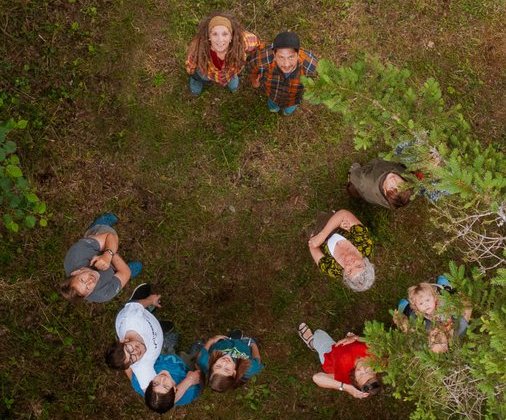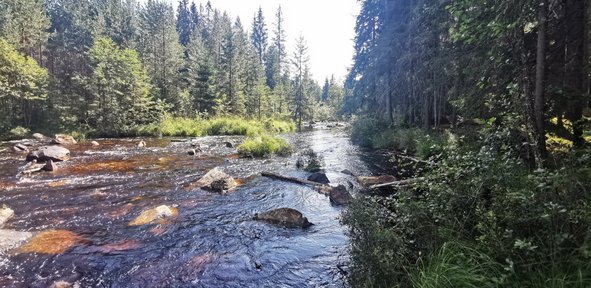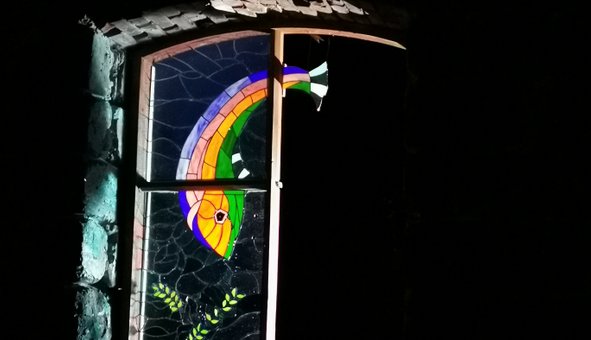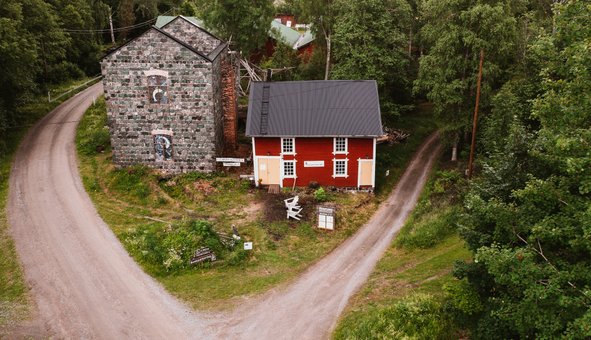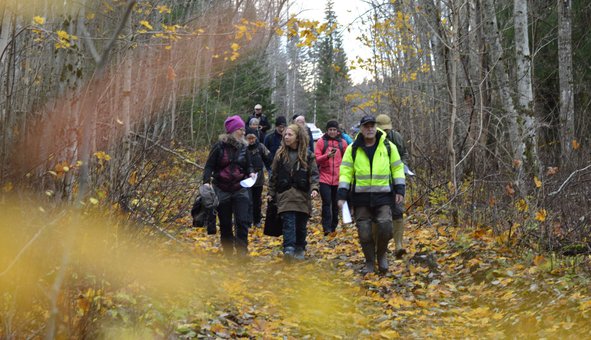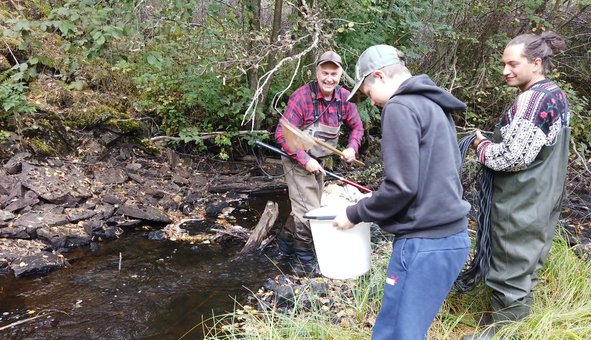About Bergslagens Visitor Center:
Scroll down or use the links below
Who are we?
Non-profit for the natures best.
Bergslagens Visitor Center (BVC) in Södra Hyttan is run by the non-profit Södra HyttOmrådets Ideella Förening (SHOIF - translation: the non profit organisation of the old foundry area called Södra Hyttan) which also has created the largest second hand book shop in Scandinavia, an art gallery hosting local artists, the cultural and world music festival HyttDreva as well as a wool center which only uses local materials. We started the work with the Vistor Center in 2017 to use cultural means of expression to explain and explore nature while also contributing to nature restoration. The area which the non-profit owns and uses for all these activities is an old foundry from the 1600s.
Where to find us
Check us on the map!
You can find us one hour north of Örebro in Bergslagen. The closest village is called Hjulsjö. Click here to see Södra Hyttan on Google Maps.
Rewilding Lankälven
All about giving back to nature
Rewilding Lankälven is a rewilding project that was set in motion when we tore down a dam. We are working towards a reestablishment of the trout population in the river and to create conditions to in the future host a fresh water pearl mussel population once again. This is done both with the help of machines and through hosting volunteer-camps in which we, among other things, return rocks, stones, gravel and organic material such as logs and branches.
The rocks were removed from the river during the industrialization of Bergslagen to allow timber to be transported along the river. But they are needed as hides for small fish and also act as microhabitats for small organisms and insects which in turn become food for the bigger fishes. Also, when the water hits the rocks it swirls and is slowes down which oxygenates the water. The floors of gravel on the bottom of the river are necessary for the reproduction of the trouts and mussels. These floors of well-oxygenated gravel beds have been destroyed through intensive clear cutting by the forestry industry.
Dead wood is both food and habitats for thousands of organisms that support functional ecosystems. There is a lack of dead wood in and around almost all water in Sweden, because the intensive logging has made clear cuts all the way to the water edges, driven with heavy machines through the streams and rivers which have lead to sterile and destroyed environments around the water. We return dead wood to the rivers, fell trees across the river and try to protect the edges around the water from being clear cut.
We are doing inventories of the life in Lankälven during our rewilding and restorations processes to see what effects our actions have had. From this we also work artistically to create a permanent outdoor exhibition that portrays the life in the river.
We also work with bats. That is, we also make inventories about the bats in the areas to know which species we have and what we can do to support them in the landscape. We also inform about the life and conditions needed for strong bat populations and work with creating both bat houses, which we have done together with local schools, and natural houses through veteranisation of trees.
We have also done inventories of the remaining old growth forests around Lankälven to try and protect them from being clear cut.
The Cathedral of Lankälven
The story of nature
In the old “warm house” there is now a permanent outdoor exhibition portraying life in Lankälven. We call the building and exhibition The cathedral of Lankälven because we have created “church windows” that portray life in the river. When you enter you are walking on the river floor and see the water surface above you. The bottom window with the fresh water peal mussels shows life below the surface, while the top window with the dragon flies shows life above the surface of the river. There are also more sculptures inside the building. In one corner you can see fresh water pearl mussels that are stood in a gravel bed. Fish are hiding on the bottom of the river. Above the water flies an osprey. The exhibition is impermanent and will develop, just like water. More art-glass windows will be created.
Thanks to this exhibition our guides can show and tell how life looks under the surface of the river, which otherwise would have been difficult. They can talk about how important the connection is between what is under the water and above the surface. For example many insects which bats eat are born on the bottom of the river. Without a thriving river there would be no bats.
About the visitor centre
Here is where the nature starts
The centre works both with rewilding and also making nature more accessible for a larger audience, especially those who do not, or cannot, experience nature by themselves. We also work with raising awareness and sharing knowledge about nature, outdoor life and cultural history in Bergslagen.
The area where the visitor centre is located has as a goal to make outside becomes inside and where culture and nature can meet on equal grounds. That which will be found inside is housed in the restored building called the “blowing house” (which historically was used to recycle warm air for melting iron). This is also the first heated house on the property which means we can have activities during the whole year. However, most of our activities will be held outside. In coming projects we aim to develop the surrounding areas.
Do you want to know more about the inventories we have done?
We have information to send about our inventories on the riverbeds (bentos), electric pulse fishing, bat inventories and forestry inventories that has lead to a nature reserve having been created.
What are we currently doing?
Updated February 2024
-We have just finished a project where we have been in dialogue with landowners to get permission to access the river for further rewilding in Lankälven.
-We will work with veteranisaiton of trees, which means creating natural habitats for bats.
-Two of our guides are preparing to become certified nature guides according to the national standard.
-We are planning our summer activities which include guided tours and workshops.
-We are creating more sculptures for the Lankälven cathedral.
-We have send in an application which has passed stage one to start building "rooms for nature" which will become a visitor's garden where we will collect native wild and cultural heritage plants to preserv them and create a biodivirsity oasis.
-We have started monitoring an abandoned mine for hibernating bats as wellt rying out a simple inventory station (with AudioMoths) in Södra Hyttan to see which species of bats stay during winter.
-Our guides are going to teach a course in how to guide at cultural heritage sites.
Our plans for the future
Updated February 2024
What are our plans for the future? (updated February 2024)
-Just outside the visitor centre we will create a public garden with native plants and an outdoor reception.
-We want to create an outdoor conference space that will we accessible regardless of disability
-We will continue the Rewilding Lankälven project and restore the river. Next step is to remove a culvert that stops the trout from swimming upstreams to the next lake, Vasslasjön.
-We will keep putting back rocks, stones, sand and gravel and a lot of dead wood into the river.
-We will create natural habitats in trees on our property to benefit the bat roosting.
-We will continue the artistic work in the cathedral of Lankälven
-We will network, hold and host presentations about our work and keep educating about nature and what we can do to give back to nature and let nature be more wild again
-We will open a souvenir shop with local handcraft and local artwork
-We will open a tea-house with herbs from our garden with native species
More things we have done
Updated February 2024
-We have have made a plan for a hiking trail that is GPS-based, to minimise ground damage by permanent trails.
-We have organised networking events for nature and cultural guides in the region.
-We have created the guiding network Outdoor People of Bergslagen so that local guides can work with ecotourism.
-We have organised lectures and presentations.
-We have welcomed many organisations and people on study visits so that we can learn from each other.
-We have held many guided tours and other outdoor activities.
-We contributed to the opening of the new nature reserve Nittälven by holding an opening talk and the guided tour of the new trail.
-We have joined the network for limnic (water based) pedagogy and held presentations about our work.
-We have joined the national organisation NAMSA and held presentations about our work.
-We have joined the European Rewilding Network.
-We have positions in the national network for educators of nature guides and the regional network for active nature- and cultural heritage guides.
-Our bat-inventories are part of a French-global research project for migratory bats.
-One of our has been on a course to become a Certified Interprative Trainer, to be able to educate nature and cultural heritage guides.
For further information please contact Alexander Baker via e-mail alexander@sodrahyttan.se
